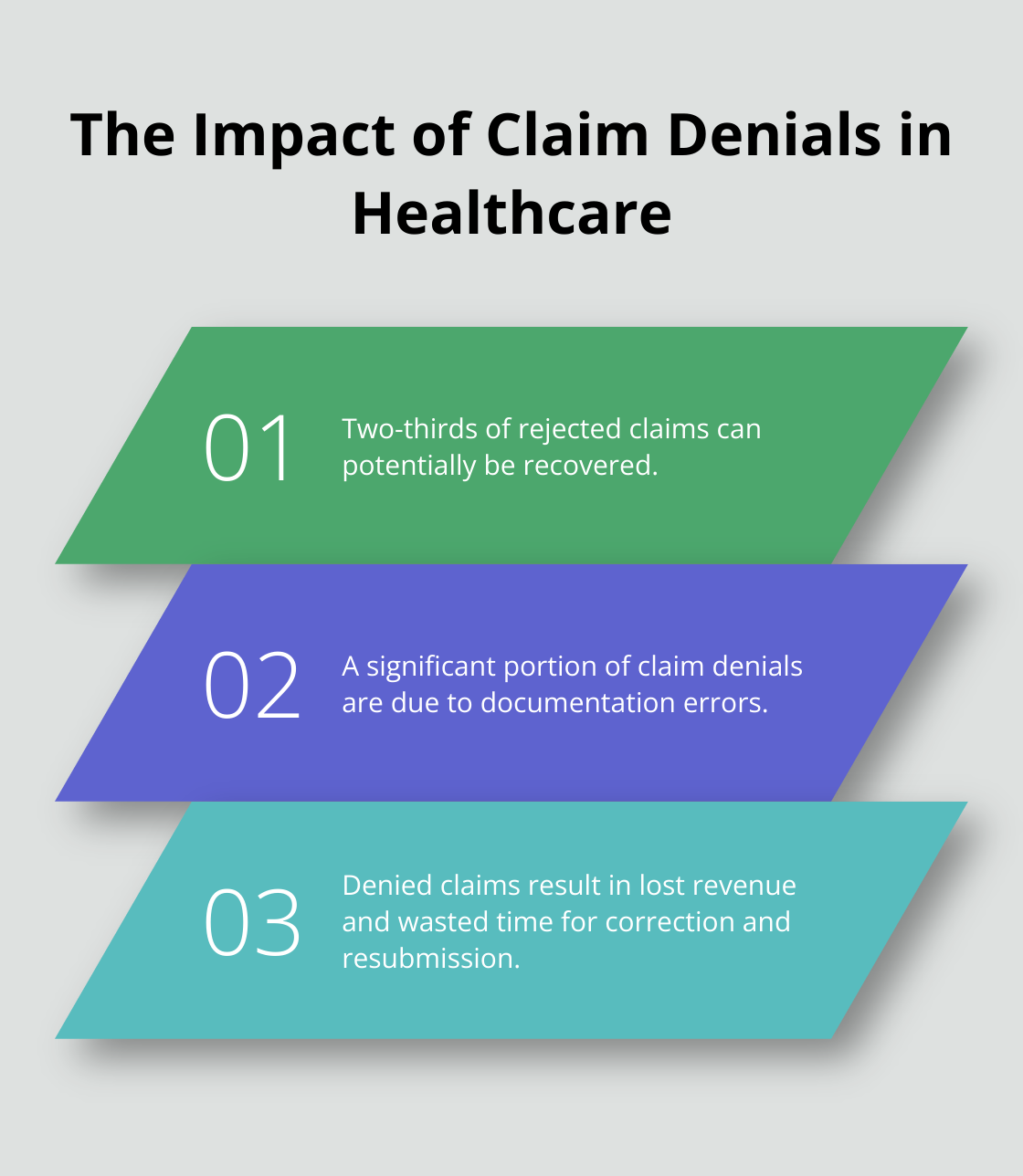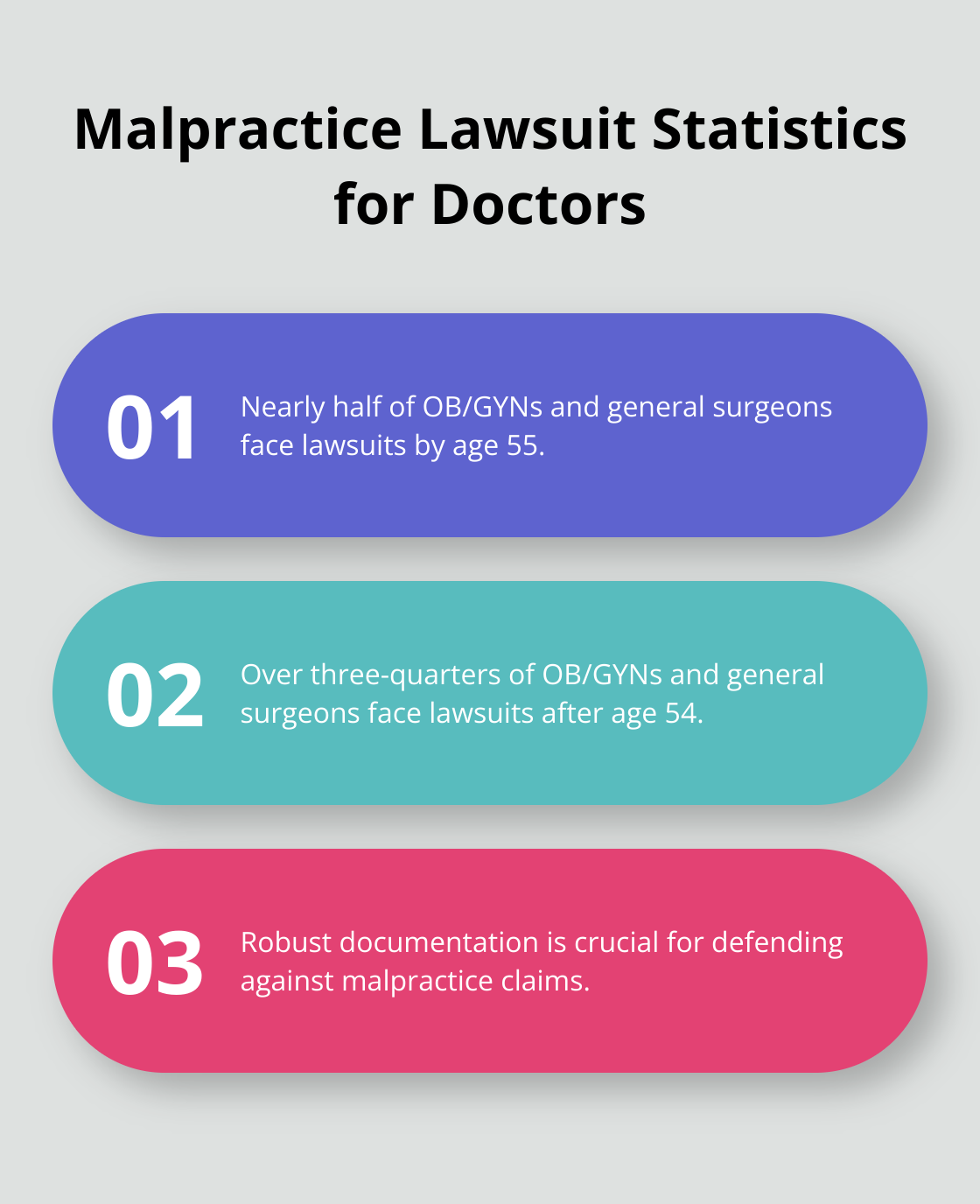Documentation errors in healthcare… yeah, they’re like the iceberg to your Titanic. You hit one — boom — you’ve got financial losses, legal headaches, and patient safety slipping through the cracks. It’s a hot mess.
Over at ScriberJoy, we’ve watched these errors rattle healthcare providers like a loose wheel on a grocery cart. This piece? It’s your roadmap to navigating the minefield of sloppy documentation. We dive into the hefty price of these blunders and toss you some practical lifelines to tighten up accuracy and keep you well within the compliance lane.
How Much Can Documentation Errors Cost You?
Documentation errors in healthcare are more than just a headache – they’re financial black holes ready to swallow your practice whole. Let’s cut through the noise and get down to how much moolah (hard-earned and soon-to-be-gone) you’re risking with shoddy documentation.
The Claim Denial Nightmare
Claim denials in healthcare are a horror show no one signed up for. Claim denials. Sounds boring, but hold on. Two-thirds of those rejected claims – yeah, you can actually get them back. A huge portion of these denials? Doc errors.

Slip up on documentation, and insurance companies are on it like flies on honey. They’ll deny claims before you can even think about saying “reimbursement.” Every denied claim doesn’t just rob you of potential revenue, it also eats up your time and energy – correcting and sending it back.
Audits and Penalties: The Double Whammy
Audits – the surprise quizzes of the healthcare world – but with your wallet on the line. Poor documentation? You might as well roll out the welcome mat for auditors setting up shop in your office.
The CMS? Oh, they don’t play. They serve penalties with an arm that sweeps through your pocket. Fines that can hit the million mark for those big fish in healthcare. Smaller practices? It’s still a punch to the gut.
The Silent Killer: Undercoding
Undercoding is the sneaky thief that robs you blind while you smile and wave. It’s like dropping cash on the floor and wandering away – clueless.
Half-baked documentation? You’re probably missing out on billing for every little thing you’ve actually done. Underbilled means underpaid – it’s like clocking in for free. And who wants that?
The Cost of Inaccuracy
Fasten your seatbelt – the impact of document goof-ups is like a runaway freight train of lost cash. Denied claims, smacking penalties, or silent undercoding, every error leads to money slipping out the side door. Accurate documentation isn’t just smart – it’s the savviest business move you’ve got.
Documentation errors aren’t just costly for you but can shake up the whole healthcare game. With tools that push the needle to maintain sky-high accuracy in medical documentation (like ScriberJoy, crowing about over 99% accuracy), sidestepping these financial traps becomes second nature. Saving cash is just the start – it’s about grabbing what’s rightfully yours for every checkbox of work done.
And next, let’s dive deep into another layer of this documentation maze: the legal thunderstorm risks ready to rain on your practice.
Legal Landmines in Healthcare Documentation
Poor documentation-it’s not just a financial sucker punch; it lays legal traps everywhere for healthcare providers. Sloppy record-keeping? It’s like rolling out the red carpet for lawsuits. Let’s dive into why messy notes can throw you into legal hot water faster than you can utter “malpractice.”
Malpractice Lawsuits: Your Paper Trail is Your Shield
In the wild world of malpractice suits, your documentation? It’s your frontline defense. Poor team communication, botched handoffs, supervisor hiccups, undertrained staff, and, oh yes, bad documentation are the culprits here. Better paperwork? Could have tilted the scales.
Imagine this scenario: you can’t prove you delivered the right care. How does one defend themselves? It’s akin to showing up to a gunfight with-yup-a water pistol. Your notes need to be spot-on, every time. Every decision, action, and patient chat should beam through your records (like a lighthouse in a foggy night).
The “He Said, She Said” Quagmire
Legal claims? Often your word vs. the patient’s. Without rock-solid documentation, you’ll be grasping at fog, trying to recall details from yesteryear. Let’s be honest, memory? It’s a rickety crutch in a courtroom.
A study shows by age 55, nearly half of OB/GYNs and general surgeons have faced lawsuits, and over 54, more than three-quarters. With stats like these, treat every patient chat like it could land in court. Because it just might.

Licensing Boards: Your Career Hangs in the Balance
Lawsuits aren’t your sole concern. Licensing boards? They hold the keys to your medical future. And guess what they zero in on during investigations? Yup-your documentation.
The Federation of State Medical Boards dished out over 8,000 disciplinary actions in 2019 alone (let that one sink in). Inadequate record-keeping was a common theme. It’s a blunt reminder: your documentation isn’t just a lawsuit shield-it protects your whole career.
The Power of Robust Documentation
Don’t roll the dice with your professional future. Invest in rock-solid documentation practices. Tools like ScribeJoy ensure your notes hit the accuracy, completeness, and compliance trifecta. In the eyes of the law and licensing boards, no documentation means-it didn’t happen.
As we shift gears, let’s peek into how these documentation missteps don’t just threaten your legal standing-they can hit the quality and safety of patient care. The ripple effects from bad documentation stretch far beyond the courtroom, reaching into the core of healthcare delivery.
How Poor Documentation Endangers Patients
Let’s get real-poor documentation isn’t just a headache for your wallet or legal troubles-it’s a straight-up danger to patient safety. So, how does shoddy record-keeping morph into a health hazard? Let’s dig in.
The Domino Effect of Miscommunication
When docs and nurses are left scratching their heads over each other’s notes, you’ve got a recipe for disaster. Communication failures whacked us with $1.7 billion in malpractice costs and racked up nearly 2,000 preventable deaths. Unclear orders, chicken-scratch handwriting, or missing pieces can mean wrong meds, missed allergies, or botched procedures.
Picture this-a Boston hospital had a horror show where a decimal point slip-up in a medication order led to a patient’s death. The dose was cranked up tenfold accidentally. And nope, this isn’t a one-off. The Institute of Medicine clocks medication errors at harming at least 1.5 million Americans each year.
Diagnosis Dilemmas from Incomplete Histories
Trying to diagnose with missing history is like solving a jigsaw puzzle with half the pieces AWOL. The Society to Improve Diagnosis in Medicine throws down that diagnostic errors mess with 12 million U.S. adults yearly (and yeah, half of those are potentially harmful).
These aren’t horror movie plots-they happen in hospitals every day. Check this-a missed penicillin allergy pops up and boom, anaphylaxis hits. Or, ignore a family history of heart disease and watch as crucial preventive care goes out the window.
Medication Mishaps from Inaccurate Records
Medication errors? You bet they’re up there in things that harm patients, and let’s be honest, dodgy documentation is often to blame. The FDA gets bombarded with over 100,000 U.S. reports yearly tied to suspected medication slip-ups.
Here’s the rundown:
- A patient’s medication list isn’t up-to-date, leading to dangerous drug combos.
- Discharge instructions are a jumbled mess, and patients end up popping pills wrong at home.
These aren’t just little hiccups-they can put lives on the line.

Combating Documentation Risks
Healthcare bigwigs need systems with some serious muscle to fight these risks. Sure, Electronic Health Records (EHRs) are part of the solution, but they’re not a cure-all. Providers should:
- Hammer in clear communication protocols to staff
- Kickstart medication reconciliation processes
- Deploy accurate transcription tools (like ScribeJoy)
Every note scribbled down could be the pivot between a patient’s road to recovery or a one-way ticket to disaster city. It ain’t just about dodging lawsuits or audits-it’s about saving lives.
Final Thoughts
Healthcare documentation errors – they’re the iceberg you don’t see until you’re already underwater. We’re talking risks that could sink providers and patients alike. Financial losses? Check. Legal headaches? Absolutely. And let’s not even get started on patient safety going totally off the rails. Priority number one (and yes, it should already be your priority) is to get this right. That means documentation that’s not just good, but spot-on accurate. Enter ScribeJoy. It’s bringing AI to the party – serving up medical transcription with those “chef’s kiss” accuracy rates.
What’s the playbook? Clear communication. You heard me. Lay down some crystal-clear protocols. Training? Essential. And don’t forget the magic of robust medication reconciliation processes. The endgame? Create a culture where meticulous record-keeping isn’t just encouraged – it’s the air you breathe. Tools like ScribeJoy aren’t just nice-to-haves, they’re your guardrails. We’re talking about avoiding showstoppers like claim denials, audits, and of course, patient care errors – the stuff that keeps you up at night.
Remember, tackling documentation errors is more than ticking compliance boxes. It’s about delivering the best darn care you can muster. For those brave enough to make accurate documentation their guiding star, the rewards are big. Financial stability? Yes, please. Stellar patient outcomes? Absolutely. It’s an investment that pays off wherever you look in the healthcare galaxy.

Leave a Reply
You must be logged in to post a comment.